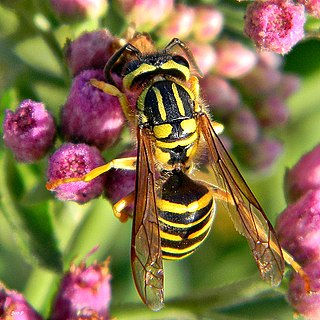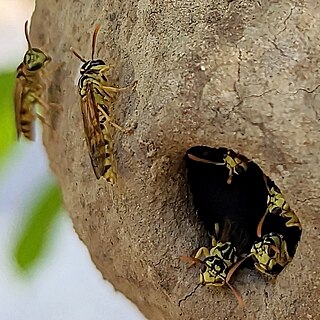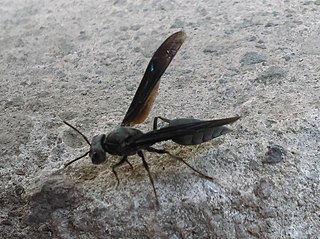
The eastern yellow jacket or eastern yellowjacket is a wasp found in eastern North America. Although most of their nests are subterranean, they are often considered a pest due to their nesting in recreational areas and buildings. This yellow jacket is a social insect, living in colonies of hundreds to thousands of individuals. Along with their subfamily, Vespinae, this species demonstrates supportive parental care for offspring, separation of reproductive and sterile castes, and overlapping generations. They aggressively defend their hives from threats and are known to inflict painful stings.

Vespula squamosa, or the southern yellowjacket, is a social wasp. This species can be identified by its distinctive black and yellow patterning and orange queen. This species is typically found in eastern North America, and its territory extends as far south as Central America. Within these territories, they create enormous, multiple-comb nests. The colonies may be either annual or perennial depending on the climate, and in many perennial nests, polygyny takes place. In addition, this species uses pheromones both as a sexual attractant and an alarm signal. This species feeds on insects and animal carcasses; it does not produce honey. V. squamosa, a social insect, has developed a parasitic relationship with the species V. vidua and V. maculifrons. Due to their painful, venomous stings, the species is considered a pest.

Brachygastra lecheguana, formerly known as Nectarina lecheguana, is a species of dark paper wasp found across North and South America. It nests in underbrush in grassland-type environments, and produces honey, characteristic of the genus Brachygastra.

Agelaia vicina is a species of wasp in the genus Agelaia. They are neotropical social wasps known to have the largest colony sizes and nest sizes among social wasps, with some colonies exceeding over one million individuals. They are predators of land arthropods, consuming both insects and spiders alike. Recent sperm morphology studies have shown that although Vespidae belong to the superfamily Vespoidea, A. vicina may be more phylogenetically related to Apoidea.

Polistes canadensis is a species of red paper wasp found in the Neotropical realm. It is a primitively eusocial wasp as a member of the subfamily Polistinae. A largely predatory species, it hunts for caterpillar meat to supply its colony, often supplementing its developing larvae with nectar. The most widely distributed American species of the genus Polistes, it colonizes multiple combs, which it rears year-round.

Synoeca cyanea, commonly known as the marimbondo-tatu in Brazil, is a swarm-founding eusocial wasp. Native to Brazil and Argentina, S. cyanea is one of the largest and most aggressive species of social wasps and is feared in many rural areas. It begins its colony cycle in the early spring and continues until nest abandonment. Throughout its life, S. cyanea forage sugary substances and animal carcasses for food and wood pulp for its nest. S. cyanea is also known for its strong venom, which is enough to cause haemolytic activity.

Protonectarina sylveirae, commonly referred to as the Brazilian wasp, is a neotropical swarm-founding wasp species that ranges widely across South America. This species relies heavily on the consumption of animal protein rather than nectar. P. sylveirae preys heavily on agricultural pests to coffee crops, keeping pest populations low.

Ropalidia revolutionalis, the stick-nest brown paper wasp, is a diurnal social wasp of the family Vespidae. They are known for the distinctive combs they make for their nests, and they have been found in Queensland, Australia in the areas of Brisbane and Townsville. They are an independent founding wasp species, and they build new nests each spring. They can be helpful because they control insect pests in gardens.
The African swarm-founding wasp, Polybioides tabidus, is a social paper wasp from the order Hymenoptera that is typically found in Central Africa. This wasp is unique in that it exhibits cyclical oligogyny, meaning queen number varies with colony cycle. After several generations of production of workers and future queens, a subset of many workers and queens leave the original colony to begin a new one. The new colony does not produce new queens until current queens from the old colony have died. P. tabidus has been observed to display both predator and scavenger behavior, depending on the food sources available.
Protopolybia exigua is a species of vespid wasp found in South America and Southern Brazil. These neotropical wasps, of the tribe Epiponini, form large colonies with multiple queens per colony. P. exigua are small wasps that find nourishment from nectar and prey on arthropods. Their nests are disc-shaped and hang from the undersides of leaves and tree branches. This particular species of wasp can be hard to study because they frequently abandon their nests. P. exigua continuously seek refuge from phorid fly attacks and thus often flee infested nests to build new ones. The wasps' most common predators are ants and the parasitoid phorid flies from the Phoridae family.

Polybia sericea is a social, tropical wasp of the family Vespidae that can be found in South America. It founds its colonies by swarming migrations, and feeds on nectar and arthropods.

Polybia emaciata is a Neotropical swarm founding wasp that is mainly found in South America. This eusocial species has a unique colony structure in which multiple queens are present. Workers and queens are not morphologically distinct, but the high amount of relatedness maintained in the colony ensures that workers police each other. Polybia emaciata relies on a diet of liquid nectars which is supplemented with prey insects, particularly flies. It is well known for being one of only three wasp species in the genus Polybia that uses mud as the primary material for building its nest. Polybia emaciata is one of the least aggressive wasp species in the genus Polybia, and is known for its distinctive defensive behavior.

Ropalidia romandi, also known as the yellow brown paper wasp or the yellow paper wasp. is a species of paper wasp found in Northern and Eastern Australia. R. romandi is a swarm-founding wasp, and manages perennial nests. Its nests are known as 'paper bag nests' and have different architectural structures, depending on the substrates from which they are built. The specific name honors Gustave, baron de Romand, a prominent French political figure and amateur entomologist.

Synoeca surinama is a Neotropical swarm-founding wasp of the tribe Epiponini. It is known for its metallic blue and black appearance and painful sting. S. surinama builds nests on tree trunks and can be found in tropical climates of South America. When preparing to swarm, there are a number of pre-swarming behaviors that members of S. surinama colonies partake in, such as buzzing runs and occasional brood cannibalism. In S. surinama, social environmental conditions determine the caste ranks of individuals in the developing brood. Unlike less primitive Hymenoptera species, S. surinama display little morphological variation between egg laying queens and workers. S. surinama wasps visit flowering plants and are considered pollinators. When these wasps sting, the stinger is left in the victim and the wasp ultimately dies.
Parachartergus fraternus is a neotropical, swarm founding, polistine wasp species that is distributed throughout Central and South America. They live in nests in second growth tropical dry forests, near pasture fields, roadside areas, and urban areas as well. These wasps eat insects, such as caterpillars of Lepidoptera. They also drink nectar, honeydew, and water. The workers capture their prey during foraging. They also use venom to paralyze their prey in order to consume it later. P. fraternus wasps are not very aggressive and they do not attack when the nest is approached.

Synoeca septentrionalis is one of five species of wasps in the genus Synoeca. It is a swarm-founding wasp that is also eusocial, exhibiting complicated nest structure and defense mechanisms and a colony cycle including a pre-emergence phase and a post-emergence phase. It is typically found in areas from Central to South America. This wasp is one of the larger species of paper wasps and exhibits multiple morphological adaptations as a result of this. Synoeca septentrionalis is known for possessing a very painful sting.

Agelaia multipicta is a swarm-founding, highly eusocial wasp that lives in Mexico, Argentina, Trinidad and southern Brazil. It nests in natural cavities such as hollow trees and aggressively defends the nest from ants, who are brood predators. The workers and queens are morphologically distinguished by ovarian development as well as external features such as a larger petiole and gaster in the queen. Like other carrion-eating (necrophagous) wasp species, A. multipicta plays a scavenging role in the ecosystem. Agelaia multipicta was described by the Irish entomologist Alexander Henry Haliday in 1836.
Parachartergus colobopterus is an epiponine social wasp belonging to the subfamily Polistinae. This species can be found through Central and South America and is unique because its colonies contain multiple queens. However, relatedness among nest mates remains relatively high as a result of cyclical oligogyny, which is a system where the number of queens varies over time. Because workers and queens do not demonstrate any significant morphological differentiation, individuals of this species are totipotent, capable of differentiation into any caste, because caste is not genetically determined. Relatedness and conflict therefore play a major role in determining the dominance hierarchy and behavioral patterns of this wasp species, especially the behavior of worker policing. Another unique characteristic of this wasp is that it is generally a docile species: when the nest is continuously provoked, the colony members will leave the nest instead of mounting an attack.
Protopolybia chartergoides, also known as Pseudochartergus chartergoides, is a species of wasp within the genus Protopolybia. It is a social wasp found in southern Central America and northern South America.

Polybia paulista is a species of eusocial wasp occurring in Brazil, Paraguay, and Argentina.















